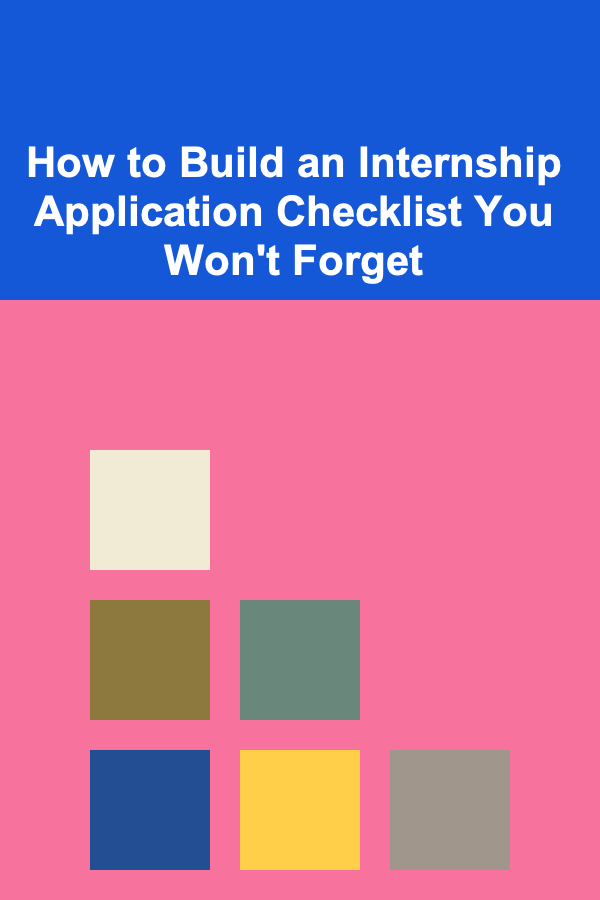
How to Build an Internship Application Checklist You Won't Forget
ebook include PDF & Audio bundle (Micro Guide)
$12.99$7.99
Limited Time Offer! Order within the next:

Internships are often the stepping stones that lead to permanent employment opportunities, providing invaluable experience and a chance to make lasting professional connections. However, applying for internships can be a time-consuming process that requires meticulous attention to detail. One of the best ways to ensure your application stands out and meets all the necessary requirements is by creating a comprehensive checklist.
In this article, we will guide you on how to build an internship application checklist that ensures you won't forget anything, giving you the best chance of landing that ideal internship.
Understand the Internship Requirements
Before diving into the application process, it's crucial to have a clear understanding of the internship's requirements. Internship postings typically include details about what the employer is looking for in a candidate, and it's essential that your application aligns with these expectations. Here are some key areas to pay attention to:
Key Details to Look for:
- Internship Type: Is it paid or unpaid? Will it be remote, in-person, or hybrid? Ensure you are aware of the work environment and conditions.
- Application Deadline: Know the submission deadline to avoid submitting late. Many internships are highly competitive, and missing the deadline can result in an automatic disqualification.
- Qualifications and Skills: Review the qualifications and skills the company is seeking. This includes educational background, specific skill sets (like software proficiency, languages, or industry-specific knowledge), and any prior experience required.
- Location: Confirm where the internship will take place. Are you required to relocate, or can it be done remotely?
How This Helps:
Knowing these requirements helps you tailor your application materials to demonstrate that you meet the internship's needs. You'll also avoid spending time on opportunities that may not fit your qualifications or interests.
Update Your Resume
A resume is the first thing employers see, and it serves as your professional introduction. To make the best impression, it's important to update your resume before applying. Here's how to do it:
Tips for a Strong Internship Resume:
- Tailor It to the Internship: Customize your resume to reflect the skills and experiences that are most relevant to the internship you are applying for.
- Highlight Relevant Experiences: If you have previous internship or work experience, emphasize the duties and achievements that align with the responsibilities of the new internship.
- Showcase Your Skills: Include technical skills (e.g., proficiency in Microsoft Office, programming languages, or design tools), soft skills (e.g., communication, teamwork), and any certifications or additional qualifications that would make you a strong candidate.
- Keep It Concise: Focus on brevity. Keep your resume to one page, especially if you're applying for internships as a student or recent graduate with limited work experience.
How This Helps:
A strong, targeted resume immediately captures the attention of employers and showcases your qualifications effectively. By focusing on relevance, you ensure that your resume stands out in a crowded applicant pool.
Craft a Customized Cover Letter
While your resume summarizes your experience and skills, your cover letter gives you a chance to express why you are interested in the internship and why you are a good fit. Here's how to create an impactful cover letter:
Key Elements of an Effective Cover Letter:
- Personalization: Address the hiring manager by name if possible. Mention the company and the specific internship you are applying for.
- Why You're Interested: Explain why you're passionate about the company, the industry, or the role. Show you've done your research and demonstrate a genuine interest.
- Your Qualifications: Briefly highlight your skills and experiences that make you a strong candidate. Use specific examples that align with the internship's requirements.
- Call to Action: Close the letter by expressing your enthusiasm for the opportunity to discuss your application further.
How This Helps:
A customized cover letter allows you to connect with the employer on a more personal level, showing that you're invested in the role and eager to contribute. It also helps set you apart from candidates who send generic applications.
Prepare Your Portfolio (If Applicable)
For internships in fields such as graphic design, writing, marketing, or technology, it's important to have a portfolio that showcases your best work. This may be an online portfolio or a PDF that you attach to your application.
Steps to Building an Effective Portfolio:
- Select Your Best Work: Include samples that are most relevant to the internship. For example, if you're applying for a social media marketing internship, provide examples of successful campaigns or content you've created.
- Organize and Label: Make sure your portfolio is organized, and each sample is clearly labeled with a description of what you did, the tools you used, and the results (if applicable).
- Showcase Versatility: If you have a diverse skill set, include a range of work to highlight your ability to adapt to different tasks or challenges.
- Keep It Updated: Make sure your portfolio includes your most recent and high-quality work. If you're just starting out, include any relevant school projects or personal projects.
How This Helps:
A strong portfolio makes a great impression by demonstrating your capabilities in real-world applications. It can also give you a competitive edge if the internship requires practical skills.
Gather Letters of Recommendation
Many internship programs, especially competitive ones, require letters of recommendation. These letters offer external validation of your qualifications and work ethic. Here's how to handle this task:
Steps to Requesting Letters of Recommendation:
- Choose Reputable Recommenders: Select individuals who know you well, such as professors, mentors, or previous employers. They should be able to speak positively and specifically about your strengths.
- Request Early: Give your recommenders plenty of time to write and submit their letters. Aim to request letters at least two to three weeks in advance of the application deadline.
- Provide Relevant Information: Provide your recommenders with context about the internship, what the employer is looking for, and your goals. This will help them write a more targeted letter.
How This Helps:
Strong letters of recommendation provide third-party endorsement, boosting your credibility and enhancing your application. It also shows you are proactive and have strong relationships with others in your academic or professional circle.
Ensure You Have the Necessary Documents
Some internships may require additional documents or forms beyond the standard resume and cover letter. Make sure you are aware of these requirements and prepare them ahead of time.
Documents to Consider:
- Transcripts: Many internships, especially those in academic or technical fields, may ask for your official or unofficial academic transcript.
- Application Forms: Some companies may provide a specific application form that needs to be filled out. Make sure you complete this thoroughly and accurately.
- Portfolio/Work Samples: As mentioned earlier, a portfolio may be required for creative roles. Make sure your work is accessible and presented professionally.
- Background Check Authorization: Some internships may require you to undergo a background check before being accepted.
How This Helps:
Having all your documents prepared in advance ensures that you don't miss any critical components of the application. Being organized and thorough demonstrates professionalism and attention to detail.
Review Your Social Media Presence
Employers often review candidates' social media profiles to get a better sense of their character and professionalism. Here's how to ensure your online presence is in check:
Steps to Manage Your Social Media:
- Clean Up Your Profiles: Remove any posts or images that may be unprofessional or controversial. If necessary, set your social media profiles to private to limit visibility.
- Showcase Relevant Content: Consider using LinkedIn to highlight your academic achievements, skills, and professional experience. Share articles or posts related to the industry you are applying to.
- Google Yourself: Do a quick search of your name to see what comes up. Ensure that your online presence aligns with the professional image you want to project.
How This Helps:
A professional online presence makes a positive impression on potential employers and may influence their decision to move forward with your application.
Double-Check Your Application
Once you've gathered all the necessary materials and completed your application, take the time to review everything carefully before submitting.
Key Things to Review:
- Proofread: Ensure there are no spelling, grammar, or typographical errors in your resume, cover letter, and any other documents.
- Follow Instructions: Make sure you have adhered to the application guidelines, such as file formats, word limits, and required documents.
- Verify Contact Information: Double-check that your contact details (email, phone number) are correct and up to date.
How This Helps:
A flawless application demonstrates professionalism and attention to detail, increasing your chances of making a positive impression.
Submit Your Application
Once everything is in place, submit your application before the deadline. Don't wait until the last minute, as issues with internet connectivity or other unforeseen problems could arise.
Final Tips:
- Confirm Submission: After submitting your application, confirm that it was received. Many companies will send you a confirmation email or message.
- Keep Track of Your Applications: Maintain a log of all the internships you've applied to, including their deadlines, submission status, and follow-up dates.
How This Helps:
Submitting on time and confirming receipt of your application ensures that you are considered for the role and keeps you organized throughout the application process.
Follow Up
It's a good practice to follow up on your application after a few weeks if you haven't heard back from the employer. A polite email thanking the hiring manager for their time and inquiring about the status of your application can help you stand out.
By following this internship application checklist, you ensure that you are fully prepared for every step of the process. With careful planning, attention to detail, and a proactive approach, you'll greatly increase your chances of landing an internship that sets you on the path to future career success.
Reading More From Our Other Websites
- [Toy Making Tip 101] DIY Keepsake Toys: Turning Special Occasions into Timeless Treasures
- [Home Space Saving 101] How to Design Space Saving Utility Room Ideas for Functionality
- [Organization Tip 101] How to Prepare Your Closet for Winter Layers
- [Organization Tip 101] How to Keep Craft Projects Organized with Folders
- [Biking 101] How to Choose the Right Bike Sunglasses for Your Ride
- [Home Soundproofing 101] How to Soundproof a Bathroom for Less Echo and Noise
- [Home Lighting 101] How to Use Globe Lights to Add a Touch of Elegance to Any Room
- [Home Space Saving 101] How to Save Space with Smart Home Technology and Gadgets
- [Soap Making Tip 101] Best Luxury Spa‑Quality Soap Formations Using Rare Essential Oils
- [Needle Felting Tip 101] DIY Needle-Felted Wall Art: Step-by-Step Guides for Beginners

How to Create a Cozy, Hygge-Inspired Home with Lighting
Read More
How to Create a Wedding Guest List and Manage Invitations
Read More
How to Set Realistic Weight Loss Goals: A Comprehensive Guide
Read More
10 Tips for Mastering Lo-Fi Music
Read More
How to Negotiate Lower Fees with Your Retirement Advisor
Read More
10 Tips for Using Daily Affirmations for Financial Abundance
Read MoreOther Products

How to Create a Cozy, Hygge-Inspired Home with Lighting
Read More
How to Create a Wedding Guest List and Manage Invitations
Read More
How to Set Realistic Weight Loss Goals: A Comprehensive Guide
Read More
10 Tips for Mastering Lo-Fi Music
Read More
How to Negotiate Lower Fees with Your Retirement Advisor
Read More